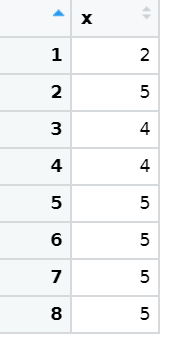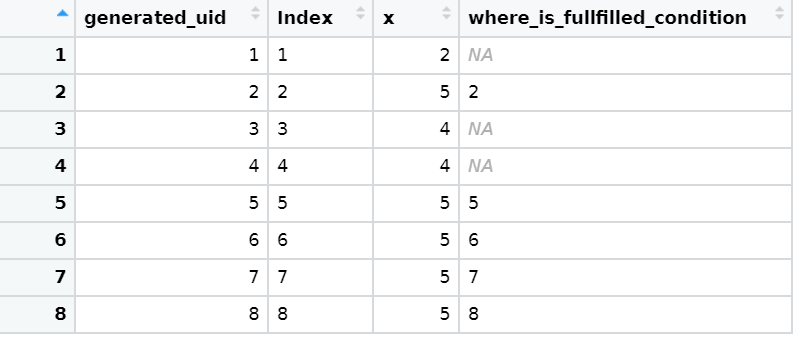Andrzej
December 13, 2020, 8:56am
1
Hi,https://forum.posit.co/t/return-the-first-position/90407/7
and this post:https://forum.posit.co/t/help-deleting-value-in-a-list-greater-than-10/52113/4
and I started with this:
x <- data.frame(x = c(2, 5, 4, 4, 5, 5, 5, 5))
which(x > 4)
So it gives me an indices of values that are greater than 4.
View(x)
and in next created column that will be indices of values that are greater than 4, and then in next column will be a column with real values greater than 4. All other cells will be filled with NA.
greater_than_4<-lapply(x,function(x)which(x > 4))
that gives me a list with indices of values, that are greater than 4 (but maybe purrr would be better than lapply), and this:
which(x > 4, arr.ind = TRUE) %>% as.data.frame()
# or:
vector_in_one_column <- as.data.frame(t(greater_than_4))
gives me a data frame with indices.
And next command gives me values, not indices:
x[x>4]
I would like to ask for advice how to glue it together into one dataframe ?
Is this what you're trying to do?
library(dplyr, warn.conflicts = FALSE)
x <- data.frame(x = c(2, 5, 4, 4, 5, 5, 5, 5))
x %>%
mutate(y = if_else(x > 4, row_number(), NA_integer_),
z = if_else(x > 4, x, NA_real_))
#> x y z
#> 1 2 NA NA
#> 2 5 2 5
#> 3 4 NA NA
#> 4 4 NA NA
#> 5 5 5 5
#> 6 5 6 5
#> 7 5 7 5
#> 8 5 8 5
Created on 2020-12-13 by the reprex package (v0.3.0)
Andrzej
December 13, 2020, 4:26pm
3
Yes, thank you, your solution is short and elegant.
x <- data.frame(x = c(2, 5, 4, 4, 5, 5, 5, 5))
greater_than_4<-lapply(x,function(x)which(x > 4))
vector_in_one_column <- as.data.frame(t(greater_than_4))
x[x, which(x > 4)]
as.data.frame(t(greater_than_4))
x <- rownames_to_column(x, "Index")
x$generated_uid <- 1:nrow(x)
x$where_is_fullfilled_condition <- ifelse( x$x >4, x$Index , NA)
x3 <- x %>% dplyr::select(generated_uid, everything())
and I accomplished that:
But I have learnt row_number() and NA_real_ from you, thank you.
1 Like
system
December 20, 2020, 4:27pm
4
This topic was automatically closed 7 days after the last reply. New replies are no longer allowed.

